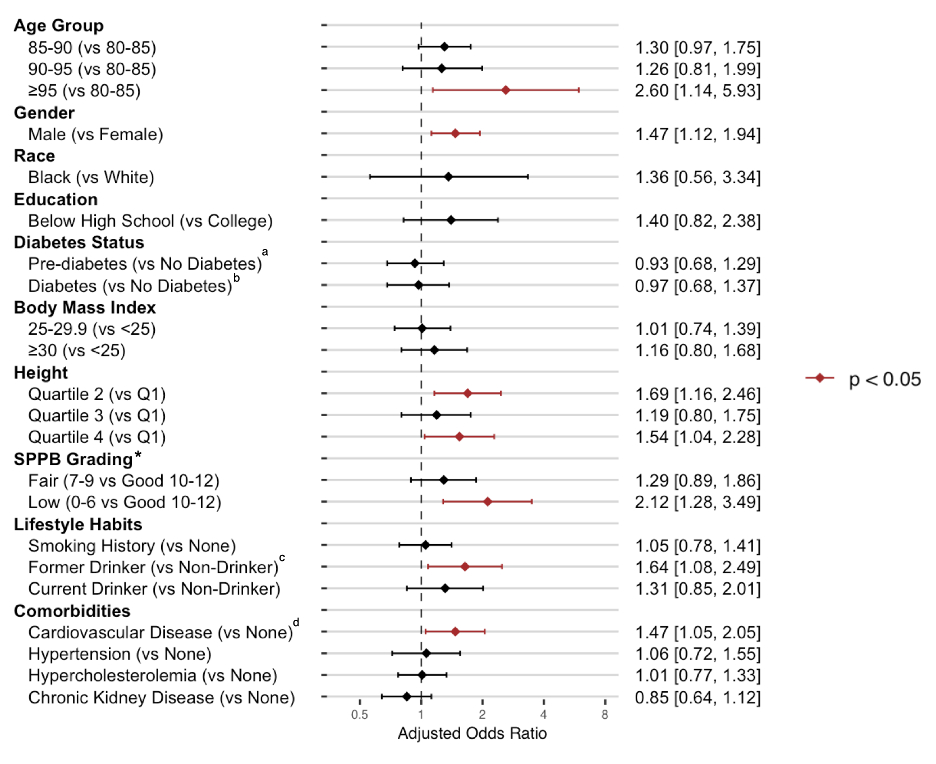Final ID: 010
Peripheral Neuropathy is Detected in More than Half of Very Old Adults
Abstract Body:
Objectives:
Emerging evidence suggests peripheral neuropathy (PN) may be more common in older individuals than previously reported, even in the absence of diabetes. However, most studies define PN by loss of protective sensation alone, a late form of PN. We aimed to quantify the prevalence and risk factors for PN in community-dwelling adults aged 80-100 years using the Michigan Neuropathy Screening Instrument (MNSI), a validated screening tool that includes a questionnaire and physical examination.
Methods:
We conducted a cross-sectional analysis of participants in the Atherosclerosis Risk in Communities Study (2022–2023) who completed the MNSI. Using age-, sex-, site-adjusted logistic regression, we quantified associations between various risk factors and PN, including education, height, body mass index, Short Physical Performance Battery (SPPB) score, lifestyle habits, and comorbidities. PN was defined by a score > 2 on the physical examination or ≥ 7 on the questionnaire portion of MNSI.
Results:
Among 993 participants (median age 84 years, 40% male, 18% Black, 30% with diabetes), 44.1% screened positive for PN. Risk factors associated with PN included advanced age (≥ 95 years vs 80-85 years, aOR 2.60), male sex (aOR 1.47), taller height (height quartile 2 and 4 vs quartile 1, aOR 1.69 and 1.54), low physical function score (SPPB 0-6 vs 10-12, aOR 2.12), former alcohol consumption (vs no alcohol drinking history, aOR 1.64), and prevalent cardiovascular disease (aOR 1.47) (Figure). Diabetes and prediabetes were not significantly associated with PN based on the MNSI, but diabetes was associated with PN based on monofilament testing for loss of protective sensation (aOR 1.51, 95% CI 1.08-2.13).
Conclusions:
PN detected by the MNSI is highly prevalent among very old adults, regardless of diabetes status. In contrast, PN in adults with diabetes is associated with loss of protective sensation. Routine screening of older adults using the MNSI may be warranted to facilitate early detection and management.
Objectives:
Emerging evidence suggests peripheral neuropathy (PN) may be more common in older individuals than previously reported, even in the absence of diabetes. However, most studies define PN by loss of protective sensation alone, a late form of PN. We aimed to quantify the prevalence and risk factors for PN in community-dwelling adults aged 80-100 years using the Michigan Neuropathy Screening Instrument (MNSI), a validated screening tool that includes a questionnaire and physical examination.
Methods:
We conducted a cross-sectional analysis of participants in the Atherosclerosis Risk in Communities Study (2022–2023) who completed the MNSI. Using age-, sex-, site-adjusted logistic regression, we quantified associations between various risk factors and PN, including education, height, body mass index, Short Physical Performance Battery (SPPB) score, lifestyle habits, and comorbidities. PN was defined by a score > 2 on the physical examination or ≥ 7 on the questionnaire portion of MNSI.
Results:
Among 993 participants (median age 84 years, 40% male, 18% Black, 30% with diabetes), 44.1% screened positive for PN. Risk factors associated with PN included advanced age (≥ 95 years vs 80-85 years, aOR 2.60), male sex (aOR 1.47), taller height (height quartile 2 and 4 vs quartile 1, aOR 1.69 and 1.54), low physical function score (SPPB 0-6 vs 10-12, aOR 2.12), former alcohol consumption (vs no alcohol drinking history, aOR 1.64), and prevalent cardiovascular disease (aOR 1.47) (Figure). Diabetes and prediabetes were not significantly associated with PN based on the MNSI, but diabetes was associated with PN based on monofilament testing for loss of protective sensation (aOR 1.51, 95% CI 1.08-2.13).
Conclusions:
PN detected by the MNSI is highly prevalent among very old adults, regardless of diabetes status. In contrast, PN in adults with diabetes is associated with loss of protective sensation. Routine screening of older adults using the MNSI may be warranted to facilitate early detection and management.
More abstracts on this topic:
Administration of the Recombinant Activated Protein C Rescues the Cardiac Vulnerability to Ischemic Insults in Aging through Modulating Inflammatory Response during Ischemia and Reperfusion
Slotabec Lily, Rouhi Nadiyeh, Seale Blaise, Wang Hao, Filho Fernanda, Adenawoola Michael, Li Ji
Advanced Age Increases Susceptibility to Ischemic Myopathy after Murine Hindlimb IschemiaKulkarni Deepali, Massie Pierce, Justus Matthew, Mazloumibakhshayesh Milad, Coffman Brittany, Pace Carolyn, Clark Ross

